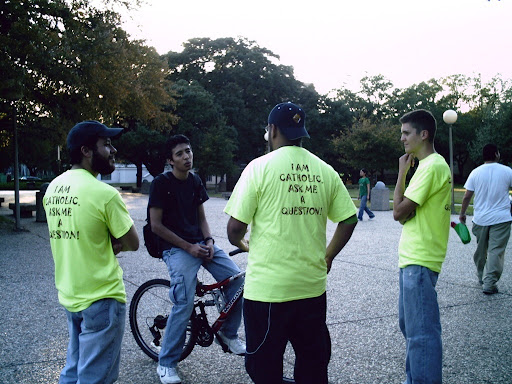by Douglas Jeffers
When we began AACAQ on the Texas A&M campus, we took out a table in the most heavily-travelled part of campus, and had students there in shifts for an afternoon. Because getting a table on campus had to be arranged with the university we were only able to do this once or twice a semester, and it was fairly ineffective. After that we hit on our current method of wearing T-shirts and standing on campus in groups of three, which not only bypasses the A&M regulations on tables, but also allows us more flexibility in several ways. First, we get a much better presence on campus because we are not confined to a particular time or place. Every group of three has an hour each week where they stand on campus, this allows us to expose ourselves to a far larger number of people, and it also gives us some permanence. It is not uncommon to hear from people that we talk to that they have seen us out there for the past couple of weeks, and have been trying to think of a question to ask us (or else to work up the courage to ask). Second, we gain the advantage of being able to work in small groups, it can be intimidating to approach a whole table full of strangers and ask them a question. Three is a much more manageable group, and it also gives us the option of having one or two group members carry on the conversation, while the others stand at a little distance, saying hello to people that walk by, in case anyone else should like to come up and ask a question. Though most of our work has been done standing on campus during the day, we have had some luck standing outside dining halls during meal times, and are considering other possibilities (e.g., standing outside the stadium on game day). In general one wants to select a location that will have a high volume of traffic, and also where people are likely to have time to stop and talk.
We also devote effort to the education and training of our members. Of course the primary means of deepening our knowledge of the faith will always be prayer and study, but there are a few things that we try to do as a group. In the first place we put all of our new members through a one-time orientation, which lasts 1 1/2 hrs. The purpose is not so much to train, as to impart an understanding of and love for the Church’s great mission to preach the Gospel to all nations. We also try to convey a sense of the evangelistic technique that we employ, namely giving a gentle witness to the Gospel, and sharing our faith with anyone interested enough to enquire.
In addition to the orientation we have general meetings once a month, during the fall and spring semesters. We do not do this more frequently because the main work of going on campus for an hour each week already takes up a considerable amount of time. At these meetings we generally have a talk on some topic that we are likely to receive questions about. Of course apologetics are only one part of evangelization, but the kind of ministry we are engaged in, where we do not personally know the people that we talk to, and where we are set up in a very public forum, while by no means excluding a more personal sharing of faith, tends to elicit questions of an apologetic nature, “Why does the Church believe…”; “Where in the Bible does it say…”; etc. Accordingly our general meetings tend to focus on imparting to everyone a clear understanding of the teaching of the Church on whatever question we are considering, and on giving a summary of the reasons that support the Church’s teaching. The talk also focuses on terminology and understanding the various kinds of people we talk to. It is important to know, for example, what words like “saved” and “grace” mean to the average evangelical Protestant, if we are going to clearly communicate our message about these subjects. After the talk we usually move into an open forum (and sometimes we devote a whole meeting to this, and dispense with the talk). This gives everyone a chance to share experiences and unite the group, and it also gives people the opportunity to raise questions, discuss questions they don’t have answers to, and pull on the group’s collective knowledge of Church teaching and how to effectively communicate it to various types of audiences. In general everyone finds this portion of the meeting to be the most helpful.
Our other method of educating our members is to send them on campus to share their faith with on-the-job training. In the end, this becomes the best way to learn how to evangelize. We try to arrange all the teams so that they have at least one experienced member, which allows new members to spend some time watching and listening, and then contributing where they feel comfortable. In general, this helps people who are nervous or shy about sharing their faith, and lets them wade into it. In all of this we stress the more one has studied and meditated on the faith, the better one’s witness will be, but that no matter how little we think we know, our witness will be worth something, and at the very least we can always tell our story, which is often the most effective tool of the evangelist. If we waited until we “knew enough” to go out and preach the Gospel it would never be preached, and we should not be afraid to put ourselves at the disposal of the Holy Spirit, for He uses very imperfect instruments.




